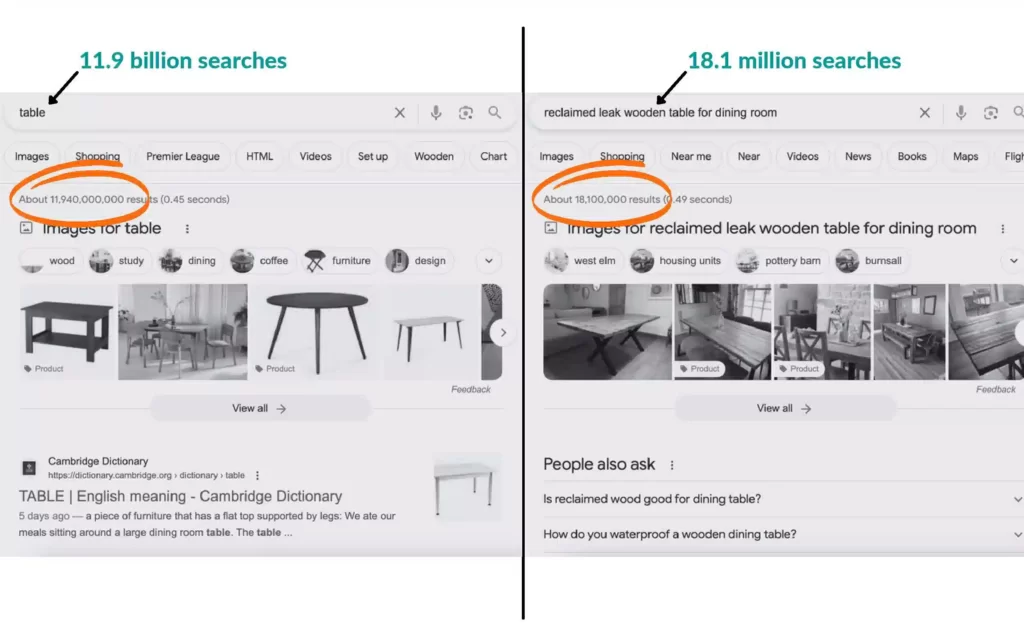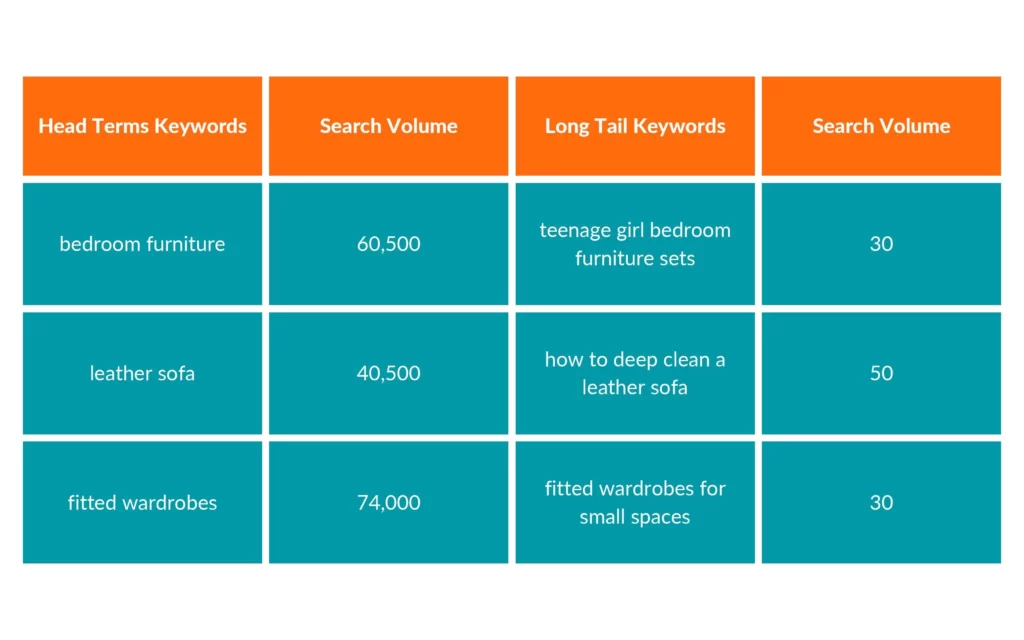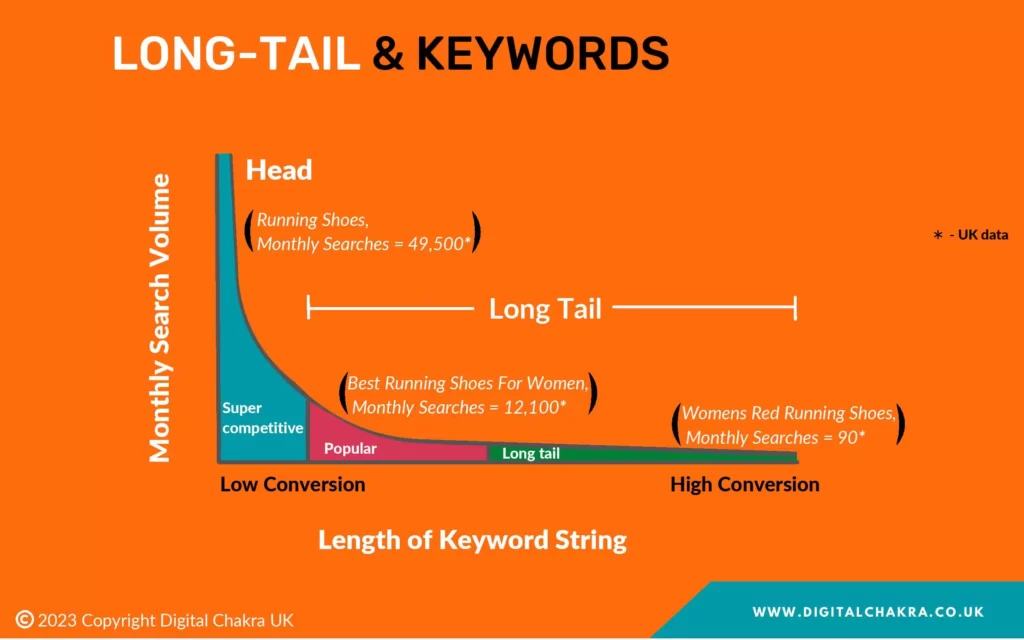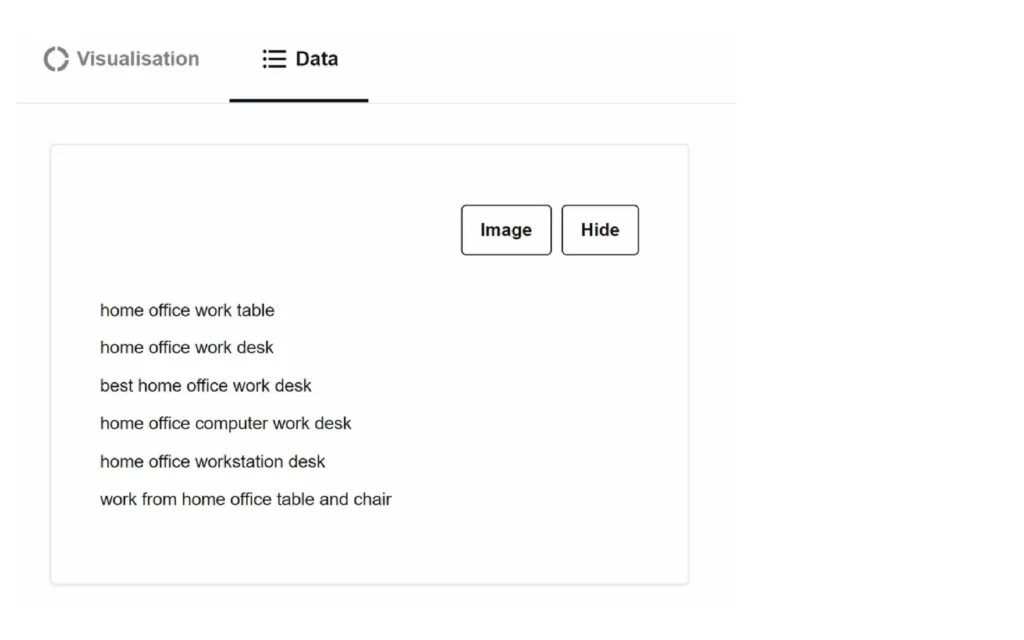
Why Long Tail Keywords For SEO? Examples, 3 Free Tools & More
Table of Contents
SEO, or search engine optimization, is crucial for online business owners who want to bring more unpaid, “organic” web traffic to their websites.
In its simplest form, SEO allows you to improve your website’s visibility when people search for keywords on Google, Bing, or other search engines. Better SEO ultimately allows you to bring more users to your website and gives you the chance to convert more people to paying customers.
However, optimizing your website’s SEO and rising to the top of Google’s search results page is not easy.
Formal keyword research is the foundational piece in SEO and one strategy that you can use to rise to the top of the search results is through the use of long-tail keywords.
What Are Long Tail Keywords?
Long tail keywords are usually phrases made up of three to five word combinations that get a small number of searches per month. The defining difference between long-tail keywords and short-tail keywords is that long-tail keywords are usually more specific than short-tail keywords.
These keywords are also relatively less competitive and more conversational than generic keywords since they are designed to better match how people actually ask questions.
Since Long Tail Keywords are narrower in scope than general search queries, they allow you to attract more high-quality traffic to your website, which is more likely to result in a higher conversion rate.
Example of Long Tail Keywords
An example of how this could affect a web search would be a searcher typing in the keyword “table”.
“Table” is non-specific and returns nearly 4.3 billion search results (as of this writing, UK) that may or may not be what the searcher is looking for.
However, if the searcher is looking to buy a reclaimed teak wooden table, a long-tail keyword search of the more specific keyword phrase “reclaimed teak wooden table for dining room” would be more likely to give them the results they are interested in.
Both the Search Volumes and corresponding Search Results are likely to be less competitive for the longer phrase.

Some other examples of long tail keywords:

Why Are The Long Keyword Phrases Called "Long Tail" Keywords?
“Long tail” is a Business strategy that allows Companies to improve profits by selling low volumes of difficult to find items, to many customers. The term was first coined in 2004 by Chris Andersen, a British American Businessman, who’s also written a book by the same name.
In the context of SEO, the “long-tail” refers to the keyword distribution graph showing internet search volume patterns.
A minuscule set of “head” keywords get exceptionally high monthly search volumes whereas billions of “tail” keywords get a disproportionately low (but still significant) number of monthly searches.

Why Should I Focus On Long Tail Keywords For SEO?
When you are optimising your website’s SEO, the use of long-tail keywords can be an incredibly powerful strategy to guide SEO efforts.
Three reasons why long-tail keywords can improve your SEO game include:
1. It is easier to rank Long Tail Keywords
Head or Short-tail keywords typically receive large amounts of search volume. Although this can be good for your website if you can get to the top, there is a lot of competition to get to the first page of search rankings, for the same keywords.
Since the Head terms are easier to incorporate into content, the majority of Sites start with them.
Competition comes in the form of blended search results including Competitor Sites, Paid Ads, Videos, People Also Ask Questions, Social Media Feeds, Industry News, and so on. This makes it really hard to rank for head/short-tail keywords, without a sizable investment of time, money, effort and resources.
The more specific nature of long-tail keywords means that fewer people are searching for them, so there is typically much less competition for these keywords.
This also means that it is ultimately much easier to get your website to rank for these results. As most clicks come from the first page of search results, it is important for your website to rank near the top if you want to increase your web traffic.
2. Long Tail Keywords reduce your need for paid advertising
A website with a higher-ranking search result gets more clicks and a higher amount of “organic” traffic. As you are trying to grow your web presence this is important.
Paid advertising is an interesting way to bypass SEO.
You can get your site to the top of Google and in front of the audience you are looking for. However, you are paying for every click which adds up in costs over time. Also, the quality of traffic that comes through Paid Advertising is often low-quality and with poor conversion rates.
As you optimize your website with long-tail keywords, for better SEO, you can replace paid advertising with unpaid web traffic that will save you money in the long term.
3. Long Tail Keywords give you a better shot at conversion
Long-tail keywords have several advantages over short-tail keywords for marketers that are looking to take into account a searcher’s intent in typing a certain keyword phrase.
The more specific nature gives long-tail keywords an advantage in that a searcher is much more likely to know what they want and be more ready to buy.
For example, a searcher looking for the term “Furniture Stores in Birmingham” is more likely to be on the path to visiting a store and converting than a searcher looking for the more generic keyword “Furniture store”.
Searchers looking for long-tail keywords often have more intent to buy and are far ahead in the customer journey than those that are searching using more general short-tail keywords.
How To Find Relevant Long Tail Keywords For FREE?
1. Search Engine Results
The easiest FREE method to find relevant long tail keywords is to use Search Engines as your ally.
Type in a simple search into the Google Search Bar and you will find it auto-filled with a list of suggested keyword queries. These are the long-tail keywords that people are using when searching for something similar.
Additionally, review the ‘related searches’ at the bottom of the Search results page.
Focus on optimizing for some of the search queries, relevant for your niche.

2. Social Aggregation & Question-Answer Sites: Quora and Reddit
Quora and Reddit are a goldmine for gathering intelligence and keyword data on a variety of topics, in any given niche.
On Reddit, explore subreddits on various topics, and find threads that have the most number of upvotes/comments. This should give you some indication of the popularity/importance of certain topics in your niche.
Similarly, Quora has Groups for different topics and audiences, so you can mine insightful data to brainstorm long-tail content ideas for your business.
3. Search Listening Tool: Answer The Public
Answer The Public is another great way to find long tail keywords. Once you enter a Seed keyword or Short Tail Keyword into the platform, it will churn out a related list of queries that people are asking online.
It isn’t the most exhaustive tool but it does allow you to tap into some useful data for Free.

There are several Paid SEO Tools that can help with Long Tail Keyword Analysis.
The Long Tail Keyword Research Tools that I’ve found the most useful include SEMRush, SE Ranking, and Mangools.
4. Google Trends
Another great way to find relevant long tail keywords is by using Google Trends (GT).
Google Trends measures the popularity of search phrases on Google. It provides a graph of interest, on a 100 point scale, for search terms that have reached a minimum threshold of searches.
Through GT, you can see if searcher interest in the keywords you want to target has gone up or down over time. It allows you to view the keyword trend data over a long time-window, going back to 2004 (when Google trends started collecting data).
Additionally, Google Trends provides keyword search data on related queries and topics.
Coming straight from Google, Google Trends data can be particularly useful to formulate your content strategy.

How Should You Build Content Using Long Tail Keywords?
1. Write Content Using The ”Long Tail Keyword” Term
After you’ve done the keyword research and found the long tail keywords you want to target, the next step is to create content around that term.
Write content that is relevant to your audience and link it to related topics that you’ve already covered. This allows for topic clustering & improving Site SEO.
2. Spread Out Your Keywords Strategically
You can optimise site content by using the long-tail keywords in multiple places including the URL, page title, header tags & body copy.
Avoid keyword stuffing or forcing keywords into your content such that it starts to sound clunky & unnatural.
Using synonyms and related semantic keywords is a great idea to further give your content an SEO boost.
How Should I Monitor The Performance Of Long Tail Keywords?
Please remember that the use of long-tail keywords is a clever strategy as long as your Site offers a good user experience and your products/services and the associated pricing are competitive.
If any of the above elements are missing, no amount of Organic Traffic, driven by long tail keywords, can help you sell more.
Monitor your long tail keyword performance by keeping an eye on your traffic and engagement rates using tools such as the Google Search Console, Google Analytics, and Bing Webmaster Tools.
Webmaster tools will tell you how many people are viewing your web page and how well your content addresses their needs.
At the end of the day, the better you are able to understand your users, the better you are able to meet their needs and draw new customers into your business.
How Many Long Tail Keyword Phrases Should I Use In my SEO Strategy? Should They All Contain 3 Words Or More?
When choosing keywords to target, it’s a good idea to use a mix of Head Keywords (competitive) and Long tail keywords. As mentioned earlier, long-tail keywords contain a minimum of 3-5 words or more.
If you are a new player in a highly competitive niche, it may be next to impossible to compete with high authority sites initially. These are the 800-pound gorillas, the likes of Amazon, Ebay, Apple, Ikea and more.
It’s better to skew in favour of Long Tail keywords while still optimising your Site for head/short-tail keywords. This will help establish authority and trust over time, for your new Brand.
If you’re in a less competitive niche and have some level of market traction, then a more balanced split between head and long tail keywords is the way to go.
In conclusion, focusing on long-tail keywords can be a great strategy for getting your website in front of online users and ultimately getting your business more customers.
Looking for help and guidance to target long-tail keywords for your ecommerce niche?
Book a FREE 20-minute SEO Discovery Call with our Senior eCommerce SEO Consultant for some helpful SEO advice.


Sorry, the comment form is closed at this time.